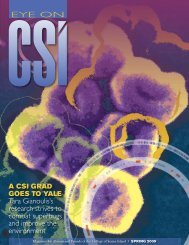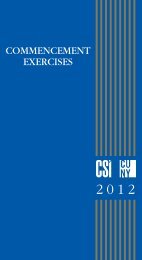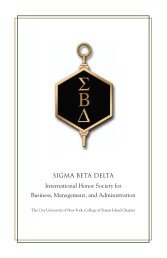csi undergraduate conference on research, scholarship ... - CSI Today
csi undergraduate conference on research, scholarship ... - CSI Today
csi undergraduate conference on research, scholarship ... - CSI Today
You also want an ePaper? Increase the reach of your titles
YUMPU automatically turns print PDFs into web optimized ePapers that Google loves.
Research Poster Presentati<strong>on</strong>sP O S T E R 3 5Engineering Printed PolymericSuperhydrophobic SurfacesMark BarahmanFaculty Mentor: Dr. Alan Ly<strong>on</strong>sDepartment of ChemistrySuper-repellent surfaces pose an extraordinaryopportunity for <strong>research</strong>ers. These surfaces displayvery high c<strong>on</strong>tact angles and low slip-angles withliquids. Research groups around the world havebeen motivated by the beauty of this phenomen<strong>on</strong>and the potential real-world applicati<strong>on</strong>s of suchcoatings. These efforts have c<strong>on</strong>centrated <strong>on</strong>creating coatings that exhibit very high roughnessand low surface energy. Such coatings can beapplied to devices for self-cleaning, n<strong>on</strong>-wettingand anti-icing purposes, and in many fields relatedto microfluidics, and fluid transport.We have been able to fabricate robust, low-cost, andhighly applicable superhydrophobic surfaces anddem<strong>on</strong>strate the ability to tune the slip-angle of ourcoatings according to need. To achieve very lowslip-angles (easy rolling), we have investigatedintroducing a sec<strong>on</strong>dary layer of roughness toprinted silic<strong>on</strong>e features.This surface design is seen in what is perhaps themost referenced natural superhydrophobic surface,the lotus leaf (Nelumbo Nucifera), which gives theplant self-cleaning and water collecting abilities.A discussi<strong>on</strong> of the cause of this effect based <strong>on</strong>c<strong>on</strong>tact-angle and slip-angle data, and severalmethods of microscopy will be included.P O S T E R 3 6Analysis of Tau Over-Expressi<strong>on</strong> inBreast Cancer Cell LinesKristina Toropova, Peter Hann<strong>on</strong>Faculty Mentor: Dr. Jimmie E. FataDepartment of BiologyThe Tau protein is a microtubule-associated proteinthat is abundant in neur<strong>on</strong>s of the central nervoussystem. It is known to stabilize microtubules bybinding to both their inner and outer surface and isa critical regulator of chromosomal alignment andseparati<strong>on</strong> during mitosis. Although Tau ispredominantly found expressed in neur<strong>on</strong>s, it isalso ectopically and abnormally expressed in breastcancer cell lines and tumors. In an effort to betterunderstand the functi<strong>on</strong> of Tau in breast tumors, wehave begun to examine the outcomes of overexpressingTau in breast cancer cell lines. Here wereport our findings, which indicate that overexpressi<strong>on</strong> of Tau in two breast cancer cell linessuppresses Tumor Necrosis Factor alpha (TNFα)-induced cell signaling. Our data has indicated thatTau can affect both pro-survival and pro-deathoutcomes in breast cancer cell lines. These findingshave begun to provide insight into the functi<strong>on</strong>alsignificance of Tau in breast cancer cell lines may inturn influence therapeutic modalities.43
















